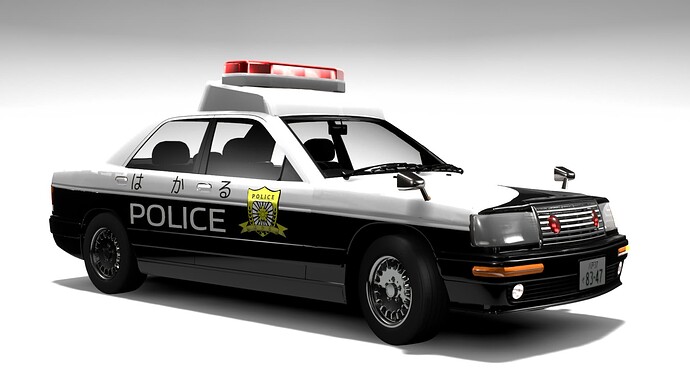That should be like rule 150 something ![]()
I make about - 8 saves per car I dig around with. Then I was forgeting what the save refers to and make another one, just in case. I’m surprised this happened to you. I, for example, do it automatically. I was spent 6 saves on my last car.
Therefore, four rules should be written down:
- Always at any stage make preserving
- Do not press the cancel button
- use morphs carefully.
- The red parts can still be saved by moving them.
- Yes.
- I don’t know which cancel button you refer to, so chances are slim that I have ever touched it.
- I disagree with you on that point. Without using morphs, cars will end up looking like copies of each other. An extensive adjustment of the morphs is the reason why this car does not look like the Rambler that the body is based on. However, now when we have the sliders, the values of them could be written down to make it easier to restore them in case of a morph reset.
- That’s completely true, however, in this case we are not talking about fixtures that have turned red, they aren’t even in the list anymore.
I may be misinterpreting, but this might be a reference to the Undo command (either through the UI button or using Control+Z.
Oh my…that’s beatiful.
Thank you sir
2017-> SAARLAND SIEGEL
OK, it’s not really a sedan, nor is it an estate. What it’s absolutely not, is a hot hatch. So, I sneak the Saarland Siegel Aerosedan (Saarland’s word for “Liftback”) into here.
In the late 90s and early 00s, there was two trends in Europe. D segment cars were growing larger and more luxurious, while the lower end of the E segment was a rapidly shrinking market. So, even though the Ambrosia was produced in 2002-03, the 2002 Siegel was really the replacement for both the smaller Polygon and the larger Ambrosia.
The second generation was introduced in 2009, and the third generation, still being in production, was released in 2017. It is available as a 5 door liftback and a 5 door wagon, meaning that there is no longer any traditional Saarland sedan on the market.
The evolution of premium sedan product by Taiman the only car manifacture of Taimania Socialist Republic.
Coming soon the the descriptions of individual model.
1972 Essex Leviathan Custom 100
The Essex Leviathan was the full size sedan offering from the Essex Motor Corporation from 1952 through 1990. This is an seventh generation Leviathan, which was produced from 1970 through 1977, and had occasional updates within that time span. During this generation, it was offered with two inline six options, and 4 v8 options. Since this is the “value” model, it has a 255 cubic inch (3.9L) inline six, which makes 153 horsepower and 212 ft-lb of torque. That gives it a 0-60 time of somewhere around 19 seconds. Additionally, the custom 100 has steel wheels, reduced amounts of chrome, taxi grade interior, among other things.
1975 AMS Starjet
Originally created for QFC2. Powered by a 4.0L I6 developing 170 bhp, so it’s not very fast, but it didn’t need to be.
At the end of the 80’s, the German brand Krüger wanted to enter the high-end sedan market, in order to increase its revenues and profits, due to its recent alliance with the Pegaso brand, already bankrupt at that time.
The vehicle, soberly named “3-Series”, consisted of a simple, inexpensive, and easy to manufacture sedan (with respect to its exterior design) in order to offer the greatest amount of luxury for the lowest possible price.
While Krüger was in charge of designing the exterior and interior, Pegaso was in charge of developing a new platform and engine. Specifically, they developed a naturally aspirated 3-liter in-line 6-cylinder engine, manufactured with an innovative indirect EFI injection system.
The engine generated an output of 201 horsepower (148 kW), a 5 speed manual transmission (or also a 4 speed automatic), a weight of about 1500 kilograms (3306 lb) and a total traction system designed specifically for this vehicle, made it a good competitor both on the track and for everyday use.
Surprisingly, it competed with vehicles like the Hansel Atlas V8, the Wagner Sigma, there was even a somewhat mediocre German sedan that tried to compete against the 3 Series, it was called… uhhhhhh… Crab… Craber? I don’t know… anyways, I don’t remember the name well.
Photos of the XD 3-Series, featuring a 3 litre Turbodiesel engine, and the X-Motion AWD System
1967 Concord Venus
The Concord Venus was the compact car offering from the Concord Motor Corporation from 1962 through the company’s bankruptcy in 1998. This second generation model, produced from 1965 through 1971 is optioned out in the “200 Deluxe” trim. This mid-level trim features AM/FM Radio, an 8 track tape deck, 2 speed “Dual-Power” automatic, as well as some other assorted extras. This particular model also has the optional 185 Cubic Inch (3.0L) V6, which came out a year prior to this car. If the V6 isn’t ordered, the standard engine is a 172 Cubic Inch (2.8L) I6. Additionally, a V8 engine had been an option since 1964, but it was only available on the sportier “Sprinter” coupe and sedan models, stations wagons, and coupe utilities.



























